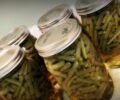Related Recipes
-
Preserving Citrus for Long-Term Storage: A Step-by-Step Guide
By Kawther
-
Zucchini Relish Recipe
By manar
-
How to Can Green Beans: A Step-by-Step Guide
By Kawther














